Middle East Battery Market Size
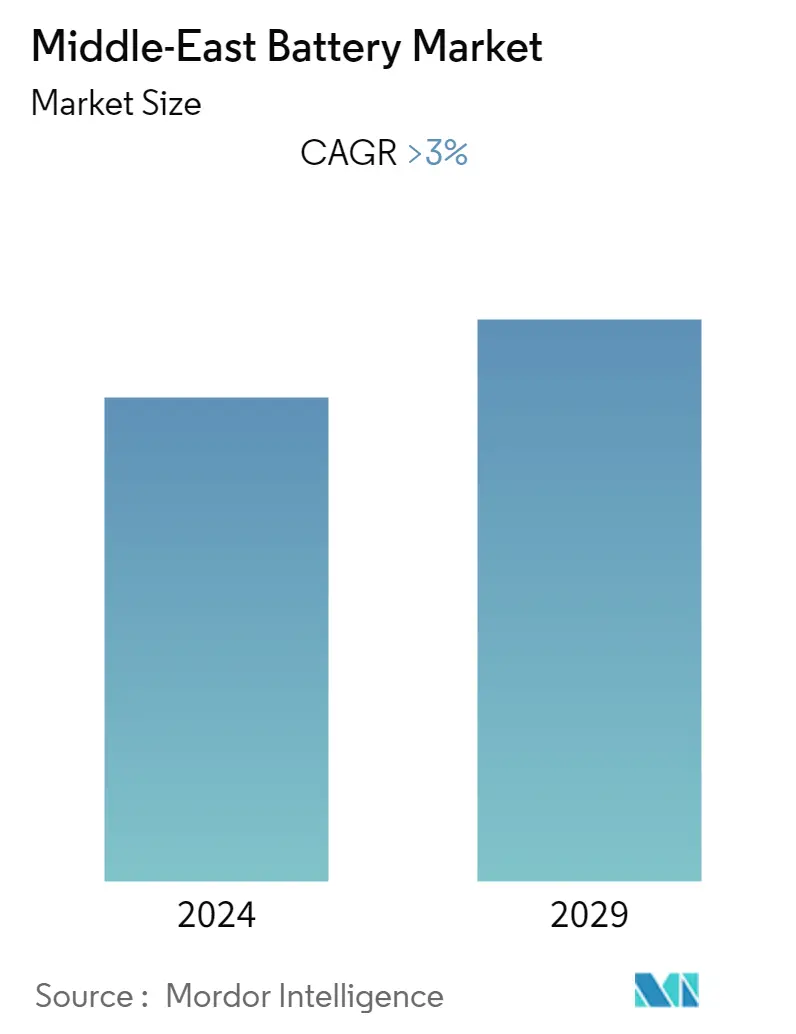
| Study Period | 2019 - 2029 |
| Base Year For Estimation | 2023 |
| Forecast Data Period | 2024 - 2029 |
| Historical Data Period | 2019 - 2022 |
| CAGR | 3.00 % |
| Market Concentration | Low |
Major Players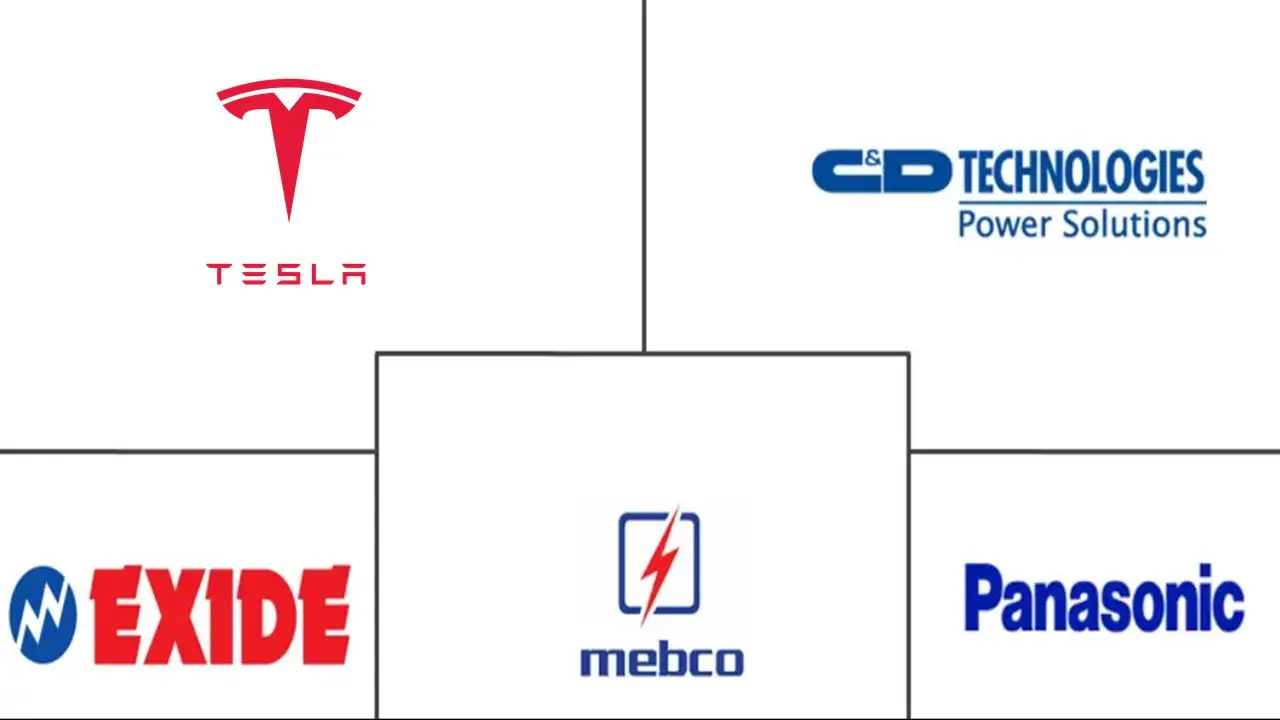
*Disclaimer: Major Players sorted in no particular order |
Middle East Battery Market Analysis
During the time frame of the forecast, the Middle East battery market is expected to grow at a CAGR of more than 3%.
The market was negatively impacted by the outbreak of COVID-19 due to regional lockdowns, leading to a decrease in demand for batteries. Currently, the market has rebounded from pre-pandemic levels.
- During the forecast period, the Middle-East battery market will be driven by things like falling prices for lithium-ion batteries, more people buying electric cars, and the growth of the renewable energy sector.
- On the other hand, the difference between raw material demand and supply is likely to slow market growth.
- Nevertheless, the rising focus on technologically advanced batteries and the use of artificial intelligence in the R&D phase of battery manufacturing is likely to create a massive opportunity for the battery companies to invest and redirect their resources to make a breakthrough in battery technology.
- The growth of the market is expected to be led by the United Arab Emirates. This is because the country's young and diverse population buys a lot of consumer electronics, like smartphones and cars.
Middle East Battery Market Trends
Lead-acid Batteries to Dominate the Market
- The lead-acid batteries segment is expected to dominate the market in both developed and emerging economies in the Middle East region during the forecast period. The growth is expected to be mainly due to the low cost of lead-acid batteries, renewable targets, and the adoption of automated guided vehicles in industrial spaces.
- The energy-to-weight ratio of the lead-acid battery is low, but it can supply large surge currents, indicating a high power-to-weight ratio primarily useful for SLI (Starting Lighting Ignition) applications. Also, due to their low cost, lead-acid batteries are preferred when the price is more important than the energy-to-weight ratio. Some areas where lead-acid batteries can be used are backup supplies for mobile phone towers, hospitals, off-grid remote storage, etc.
- Lead-acid batteries in automotive applications contribute to more than half of the market. Automotive (excluding electric vehicles) batteries are mostly SLI batteries, and the lead-acid battery can also be used for applications like in-vehicle entertainment systems, power steering, power locking, power window systems, etc.
- As of 2022, the import value of lead-acid accumulators of the kind used for starting piston engines across the Middle East was about USD 538 million.
- Therefore, based on the abovementioned factors, the lead-acid battery segment is expected to maintain its growth momentum and dominate the Middle East region during the forecast period.
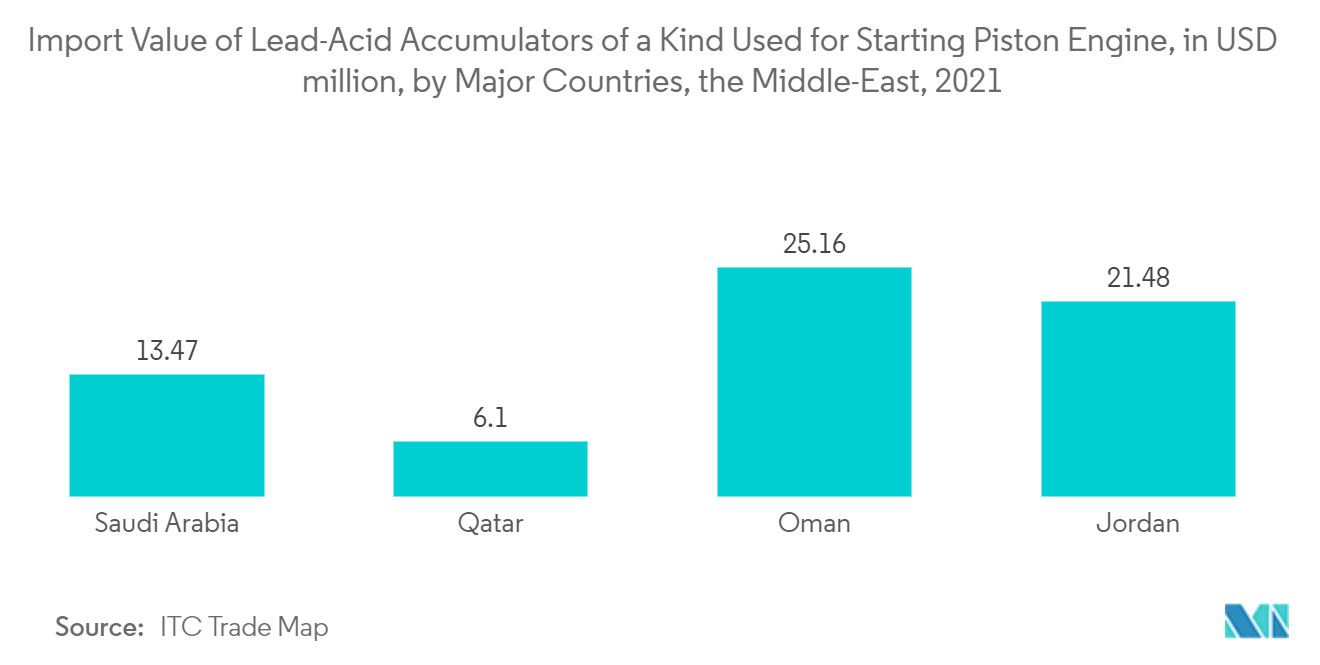
The United Arab Emirates to Dominate the Market Growth
- The United Arab Emirates is likely to lead the growth of the market over the next few years. This is because there is more demand for consumer electronics and more sales of cars, which are expected to increase the demand for both primary and secondary batteries.
- People in the United Arab Emirates, who are mostly young and from different backgrounds, are likely to buy a lot of consumer electronics, like smartphones and cars. For instance, the total shipments of mobile phones to the United Arab Emirates in the first quarter of 2022 were around 1.5 million units, worth about USD 494.6 million. In terms of share, smartphones accounted for 90.7% of the total number of shipments, compared to 9.3% for traditional phones. In the United Arab Emirates, the demand for prismatic and cylindrical battery cells is likely to rise as more and more people buy consumer electronics.
- Due to the growing population, the construction and building industry is also one of the fastest-growing industries. Infrastructure development projects in line with Expo 2020 (such as the Abu Dhabi Metro and Etihad Rail Network), booming industrialization, and construction activities are expected to be on the higher side in the country, which in turn is expected to supplement the demand for batteries for activities such as backup, lighting, and power tools, which is likely to propel demand for pouch batteries (used in cordless power tools such as drilling tools) and the cylindrical battery cell market in the near future.
- In March 2022, M Glory Holding Group put money into making the United Arab Emirates a better place to make EVs. The total investment in the plant is around USD 410 million. The plant's capacity would be around 55,000 EVs a year, expected to be the highest in the Middle East region. Furthermore, the company also introduced its first electric car, the Al Damani DMV300, to the market. resulting in more demand for the prismatic as well as cylindrical battery cell in the automobile sector.
- The United Arab Emirates has a better charging infrastructure, with Dubai having around 530 charging stations and around 120 spread across the country as of 2021. Major EV manufacturers are launching their new models of EV in the United Arab Emirates. Some of these are the BMW i8, Mercedes-Benz GLC 350e, Renault Zoe, and Chevrolet Bolt.
- Therefore, based on the abovementioned factors, the United Arab Emirates is expected to dominate Middle-East battery market growth during the forecast period.
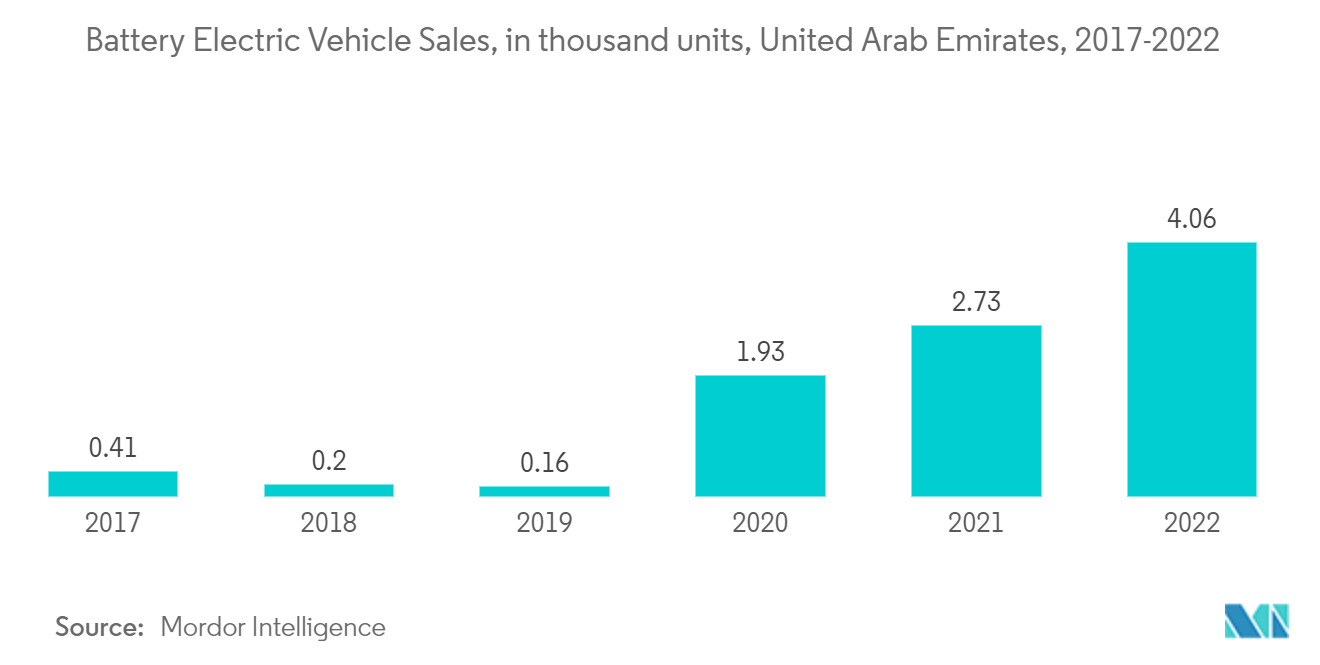
Middle East Battery Industry Overview
The Middle East battery market is fragmented. Some of the major players (in no particular order) include Tesla Inc., C&D Technologies Inc., Exide Industries Ltd., the Middle East Battery Company (MEBCO), and Panasonic Corporation.
Middle East Battery Market Leaders
-
Exide Industries Ltd
-
Middle East Battery Company (MEBCO)
-
C&D Technologies Inc.
-
Panasonic Corporation
-
Tesla, Inc.
*Disclaimer: Major Players sorted in no particular order
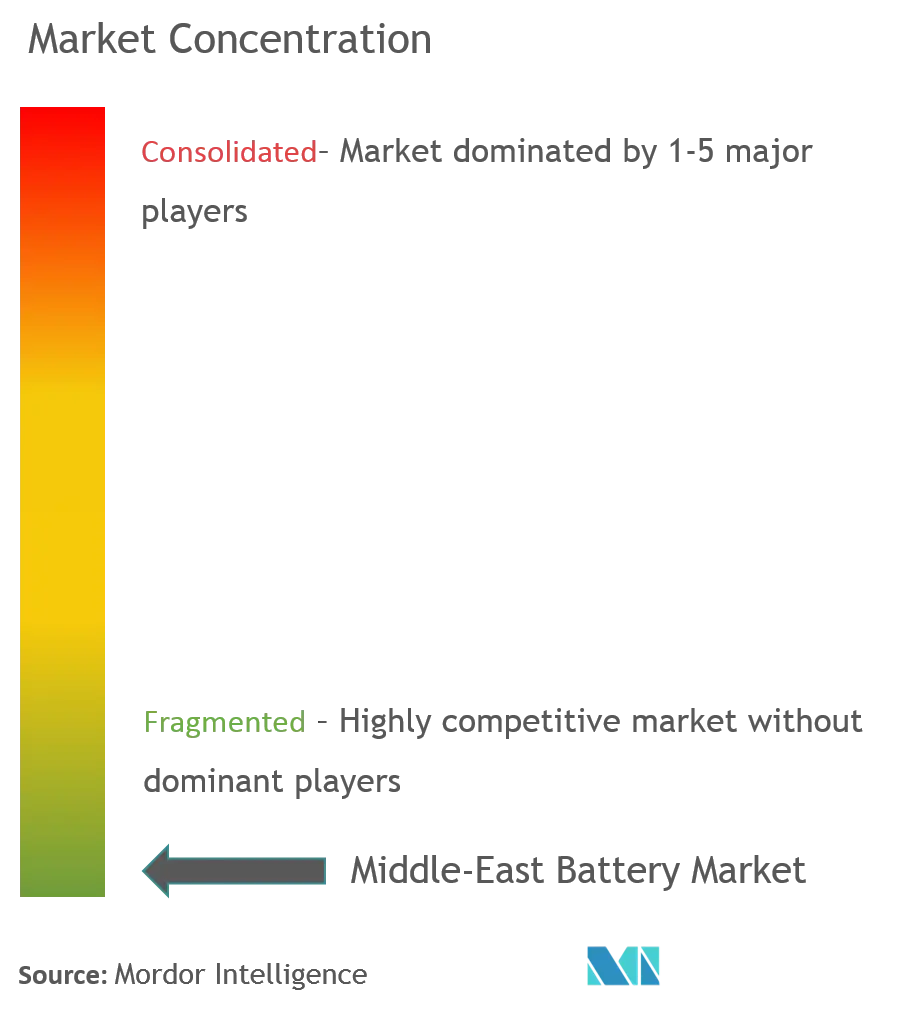
Middle East Battery Market News
- May 2022: Saudi Arabia's Ministry of Industry and Mineral Resources announced that it had secured USD 6 billion for a steel plate mill complex and an electric vehicle battery metals plant. Out of the total amount of USD 6 billion, USD 2 billion will be allocated for the electric vehicle battery metals plant.
- January 2023: EV Metals Group (EVM) signed agreements for the allocation of 127 hectares of land from the Royal Commission for Jubail and Yanbu (RCJY) and a gas and power allocation from the Saudi Ministry of Energy. The agreements support EVM's planned USD 899 million integrated Battery Chemicals Complex at Yanbu Industrial City.
Middle East Battery Market Report - Table of Contents
1. INTRODUCTION
- 1.1 Scope of the Study
- 1.2 Market Definition
- 1.3 Study Assumptions
2. RESEARCH METHODOLOGY
3. EXECUTIVE SUMMARY
4. MARKET OVERVIEW
- 4.1 Introduction
- 4.2 Market Size and Demand Forecast in USD billion, till 2028
- 4.3 Recent Trends and Developments
- 4.4 Government Policies and Regulations
-
4.5 Market Dynamics
- 4.5.1 Drivers
- 4.5.2 Restraints
- 4.6 Supply Chain Analysis
-
4.7 Porter's Five Forces Analysis
- 4.7.1 Bargaining Power of Suppliers
- 4.7.2 Bargaining Power of Consumers
- 4.7.3 Threat of New Entrants
- 4.7.4 Threat of Substitute Products and Services
- 4.7.5 Intensity of Competitive Rivalry
5. MARKET SEGMENTATION
-
5.1 Type
- 5.1.1 Primary Battery
- 5.1.2 Secondary Battery
-
5.2 Technology
- 5.2.1 Lead-acid Battery
- 5.2.2 Lithium-ion Battery
- 5.2.3 Other Technologies
-
5.3 Application
- 5.3.1 Automotive
- 5.3.2 Industrial Batteries (Motive, Stationary (Telecom, UPS, Energy Storage Systems (ESS), etc.)
- 5.3.3 Consumer Electronics
- 5.3.4 Other Applications
-
5.4 Geography
- 5.4.1 United Arab Emirates
- 5.4.2 Saudi Arabia
- 5.4.3 Rest of the Middle-East
6. COMPETITIVE LANDSCAPE
- 6.1 Mergers and Acquisitions, Joint Ventures, Collaborations, and Agreements
- 6.2 Strategies Adopted by Leading Players
-
6.3 Company Profiles
- 6.3.1 Tesla Inc.
- 6.3.2 Panasonic Corporation
- 6.3.3 Saft Groupe SA
- 6.3.4 Middle East Battery Company (MEBCO)
- 6.3.5 C&D Technologies Inc.
- 6.3.6 EnerSys
- 6.3.7 Exide Industries Ltd
- 6.3.8 FIAMM Energy Technology SpA
- 6.3.9 Statron Ltd
- *List Not Exhaustive
7. MARKET OPPORTUNITIES AND FUTURE TRENDS
** Subject To AvailablityMiddle East Battery Industry Segmentation
A battery is an electrochemical device with one or more electrochemical cells that can be charged with an electric current and discharged when needed. Batteries are usually devices that are made up of multiple electrochemical cells that are connected to external inputs and outputs. The Middle East battery market is segmented by type, technology, application, and geography. By type, the market is segmented into primary and secondary batteries. By technology, the market is segmented into lead-acid batteries, lithium-ion batteries, and other technologies. By application, the market is segmented into automotive batteries, industrial batteries, consumer electronics, and other applications. The report also covers the market size and forecasts for the battery market across the major countries in the region. For each segment, market sizing and forecasts have been done based on revenue (USD billion).
| Type | Primary Battery |
| Secondary Battery | |
| Technology | Lead-acid Battery |
| Lithium-ion Battery | |
| Other Technologies | |
| Application | Automotive |
| Industrial Batteries (Motive, Stationary (Telecom, UPS, Energy Storage Systems (ESS), etc.) | |
| Consumer Electronics | |
| Other Applications | |
| Geography | United Arab Emirates |
| Saudi Arabia | |
| Rest of the Middle-East |
Middle East Battery Market Research FAQs
What is the current Middle-East Battery Market size?
The Middle-East Battery Market is projected to register a CAGR of greater than 3% during the forecast period (2024-2029)
Who are the key players in Middle-East Battery Market?
Exide Industries Ltd , Middle East Battery Company (MEBCO) , C&D Technologies Inc., Panasonic Corporation and Tesla, Inc. are the major companies operating in the Middle-East Battery Market.
What years does this Middle-East Battery Market cover?
The report covers the Middle-East Battery Market historical market size for years: 2019, 2020, 2021, 2022 and 2023. The report also forecasts the Middle-East Battery Market size for years: 2024, 2025, 2026, 2027, 2028 and 2029.
What are the key factors driving the growth of the Middle East battery market?
The key factors driving the growth of the Middle East Battery Market are a) Increasing demand for electric vehicles (EVs) and renewable energy sources b) Growth of the construction and building sector c) Rising proliferation of connected devices d) Growing demand for utility-scale energy storage projects
Battery in Middle East Industry Report
The Middle East battery market is experiencing significant growth, driven by various factors across different market segments, including a robust demand in sectors such as automotive, industrial, and portable batteries. This market growth is further fueled by a shift towards sustainable and renewable energy sources, largely influenced by the increasing adoption of electric vehicles and the need for effective energy storage solutions to accommodate the intermittent nature of renewable sources like solar and wind. Additionally, the construction and building sector, supported by industrialization and a growing population, is playing a crucial role in propelling the demand for batteries, necessary for backup, lighting, and power tools.
Innovations such as Nuclear Diamond Batteries (NDBs) are introducing revolutionary changes in energy generation and storage, offering durable and scalable solutions across various applications. Despite challenges such as environmental concerns related to battery disposal and management, the market is poised for expansion, fueled by technological advancements and increasing investments in battery technology and infrastructure by Middle East battery companies.
The market size and forecasts are provided in terms of value for all the above segments. For detailed statistics on the Middle East battery market share, size, revenue growth rate, and a market forecast outlook, refer to industry reports by Mordor Intelligence™, available as a free report PDF download. The market overview highlights the significant industry growth and market analysis, providing insights into the market data and market segmentation.
Industry reports indicate a positive market outlook, with market leaders driving advancements in battery technology. The market review covers various market predictions and market trends, offering a comprehensive market overview and market statistics. The industry analysis provides a detailed industry profile, including industry sales and industry size, essential for understanding the industry's current state and future prospects.
Research companies have highlighted the market value and market forecast, emphasizing the importance of market research and industry research in identifying opportunities and challenges within the market. The report example and report pdf offer valuable insights into the market's trajectory, supported by industry information and industry outlook.
Overall, the Middle East battery market's growth rate is promising, with industry trends pointing towards continued expansion and innovation. The market forecast and market predictions suggest a robust future for the industry, driven by technological advancements and increasing investments in battery technology and infrastructure.



